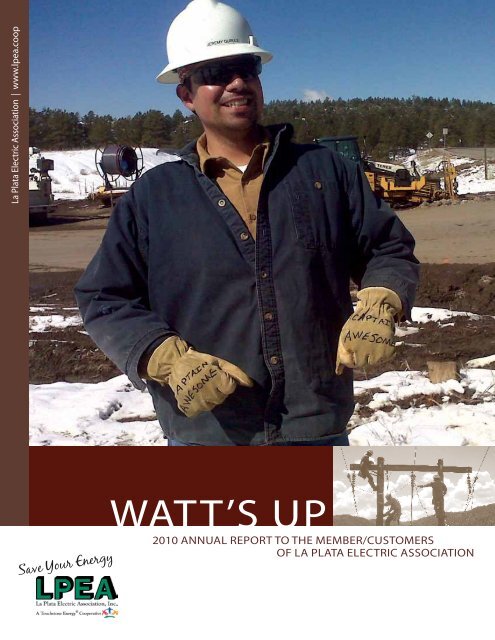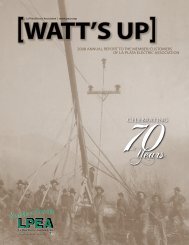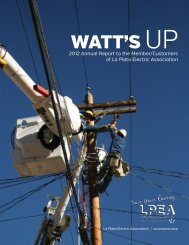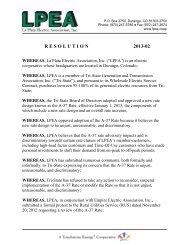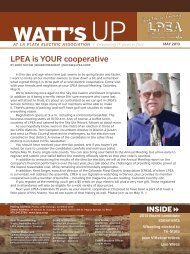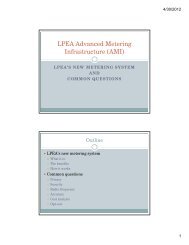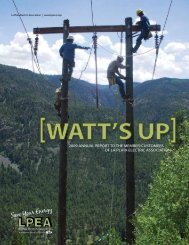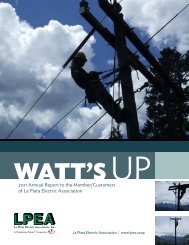2010 LPEA Annual Report - La Plata Electric Association, Inc.
2010 LPEA Annual Report - La Plata Electric Association, Inc.
2010 LPEA Annual Report - La Plata Electric Association, Inc.
Create successful ePaper yourself
Turn your PDF publications into a flip-book with our unique Google optimized e-Paper software.
<strong>La</strong> <strong>Plata</strong> <strong>Electric</strong> <strong>Association</strong> | www.lpea.coop<br />
watt’s up<br />
Save Your Energy<br />
<strong>2010</strong> <strong>Annual</strong> <strong>Report</strong> to the member/customers<br />
of <strong>La</strong> plata electric association
It’s not R2-D2<br />
But it could be the “Star Wars”<br />
of water heaters.<br />
If Luke Skywalker had his choice of<br />
electric water heaters, he certainly<br />
would select a Marathon. With the<br />
toughest tank in the residential<br />
water heater industry, Marathon is<br />
revered for its construction, with<br />
no rust, no corrosion. The models<br />
excel at energy efficiency, and with<br />
the “no-leak” lifetime warranty, a<br />
Marathon is likely the only water<br />
heater you’ll ever need to buy for<br />
your home. “The Force” (in heating<br />
water) could be with you.<br />
To invest in the best, call <strong>La</strong> <strong>Plata</strong> <strong>Electric</strong> <strong>Association</strong><br />
970.247.5786 | www.lpea.coop<br />
Save Your Energy
6 10 12<br />
watt’s up<br />
Watt’s Up is a publication of <strong>La</strong> <strong>Plata</strong> <strong>Electric</strong><br />
<strong>Association</strong>, produced by members for members<br />
of <strong>LPEA</strong> in Durango, Colorado.<br />
Editor<br />
Indiana Reed<br />
<strong>La</strong>yout & Design<br />
Lisa Morales Eccher, Chimera Communications<br />
Printing & Distribution<br />
Basin Printing & Imaging<br />
Mission Statement<br />
<strong>La</strong> <strong>Plata</strong> <strong>Electric</strong> <strong>Association</strong> provides its members<br />
safe, reliable electricity at the lowest reasonable cost<br />
while being environmentally responsible.<br />
Mailing Address:<br />
PO Box 2750<br />
Durango, Colorado 81302-2750<br />
Street Address:<br />
45 Stewart Street | Durango, Colorado 81303<br />
603 S. 8th Street | Pagosa Springs, Colorado 81147<br />
970.247.5786 | www.lpea.coop<br />
<strong>2010</strong> <strong>Annual</strong> <strong>Report</strong> to the member/customers<br />
of <strong>La</strong> plata electric association<br />
A dynamic industry, no doubt | 2<br />
By Greg W. Munro, Chief Executive Officer<br />
Part of everything you do… | 3<br />
By Indiana Reed, Marketing Communications Specialist<br />
From the President | 4<br />
Maintaining a legacy of reliability and fiscal responsibility<br />
By Terry Alley, President, <strong>LPEA</strong> Board of Directors<br />
Year of the lights | 6<br />
Lighting retrofits saving energy and dollars<br />
By Mark Schwantes, Manager of Corporate Services<br />
<strong>2010</strong> Financials | 8<br />
Substations: Substance over beauty | 10<br />
By Dave Gebhardt, Major Projects Engineer<br />
Statement of Nondiscrimination<br />
<strong>La</strong> <strong>Plata</strong> <strong>Electric</strong> <strong>Association</strong>, <strong>Inc</strong>. is the recipient of<br />
Federal financial assistance from the U.S. Department<br />
of Agriculture (USDA). The USDA prohibits discrimination<br />
in all its programs and activities on the basis of race,<br />
color, national origin, age, disability, and where applicable,<br />
sex, marital status, familial status, parental status, religion,<br />
sexual orientation, genetic information, political beliefs,<br />
reprisal, or because all or part of an individual’s income<br />
is derived from any public assistance program.<br />
(Not all prohibited bases apply to all programs.)<br />
Persons with disabilities who require alternative<br />
means for communication of program information<br />
(Braille, large print, audiotape, etc.) should contact<br />
USDA’s TARGET Center at (202) 720-2600 (voice and<br />
TDD). To file a complaint of discrimination, write to<br />
USDA, Director, Office of Civil Rights, 1400 Independence<br />
Avenue, S.W., Washington, D.C. 20250-9410, or call toll<br />
free (866) 632-9992 (voice) or (800) 877-8339 (TDD) or<br />
(866) 377-8642 (relay voice users). USDA is an equal<br />
opportunity provider and employer.<br />
The little bit that helps a lot… | 12<br />
<strong>LPEA</strong> Round Up Foundation<br />
By Indiana Reed, Marketing Communications Specialist<br />
Power Points | 14<br />
<strong>2010</strong> Employees | 16<br />
On the Cover: Mechanic Jeremy Gurule is part of <strong>LPEA</strong>’s Operations team working to keep<br />
the lights on. Photo: Ben Cordova<br />
<strong>La</strong> <strong>Plata</strong> <strong>Electric</strong> <strong>Association</strong> | www.lpea.coop 1
photo: indiana reed<br />
Greg W. Munro,<br />
Chief Executive Officer<br />
From the CEO<br />
A dynamic industry, no doubt<br />
The year <strong>2010</strong> went by about as fast as any year I’ve experienced. We at <strong>LPEA</strong> were<br />
all very busy, and accomplished a great deal. The many challenges we encountered<br />
throughout the year were faced head-on by a very talented and dedicated staff.<br />
In spite of the economic downturn, engineering and construction of new<br />
(and much needed) electrical facilities and system improvements, plus regular<br />
maintenance, steadily filled each work day to help ensure that we kept the lights on<br />
for you, our members.<br />
I’m pleased to say that we also accomplished the goals and objectives we<br />
established at the beginning of <strong>2010</strong>, which continue to meet the <strong>LPEA</strong> mission.<br />
For example:<br />
• We now have more than 1 megawatt (MW) of small renewable energy on our grid<br />
to complement the existing 18 MWs of renewable generation already connected;<br />
• We’ve helped our members save well in excess of 15 million kilowatt hours of<br />
electricity with our many energy efficiency programs;<br />
• We have installed more than 50 megawatts of new capacity;<br />
• Our system reliability exceeds 99 percent;<br />
• Our rates to the membership remain stable;<br />
• We have prepared <strong>LPEA</strong> for the future by refinancing some of our loans at lower<br />
interest rates, and have obtained financing for future infrastructure needs;<br />
• We have met all the requirements of the various Federal, State and County<br />
regulations;<br />
• We have met all the financial requirements mandated for electric cooperatives<br />
such as <strong>LPEA</strong>.<br />
As we ended <strong>2010</strong>, we looked ahead to new challenges, which likely will be<br />
difficult for all of us to face. Simply put, rates are going to increase in 2012, and each<br />
year beyond, due to a number of factors including fuel costs, regulations, legislative<br />
actions and issues on a global scale.<br />
Tri-State Generation and Transmission <strong>Association</strong>, our wholesale power supplier,<br />
is in the midst of developing new rate structures. As purchasing this power is more<br />
than 70 percent of <strong>LPEA</strong>’s total expenses, the impact of these new rates could be<br />
significant.<br />
Beyond the cost of electricity, the new rate structure may also impact our many<br />
energy efficiency programs and rebates, and at this writing, we don’t know whether<br />
those impacts will be positive or negative. As always, we will remain very engaged<br />
in these rate adjustment discussions, and will continue to represent our members’<br />
interests with Tri-State to provide energy in the most efficient and effective manner.<br />
Also on the horizon, we are facing new federal rules and regulations regarding<br />
reliability, and we’re working on how best to handle these, including the transfer of<br />
our semi-bulk transmission facilities to Tri-State.<br />
The good news is that, as noted above, installation of local renewable generation<br />
is increasing, and so is energy efficiency. Energy efficiency is, after all, the most<br />
cost-effective method for reducing energy consumption and costs. We’ll help you<br />
however we can.<br />
In <strong>2010</strong> <strong>LPEA</strong> and our members fared well, but it’s a new era ahead, and though<br />
we don’t have a crystal ball, we continue to do our best to forecast the needs of our<br />
members, and adhere to our mission to provide our members safe, reliable electricity<br />
at the lowest reasonable cost while being environmentally responsible. 4<br />
2 <strong>La</strong> <strong>Plata</strong> <strong>Electric</strong> <strong>Association</strong> | www.lpea.coop
<strong>La</strong> <strong>Plata</strong> <strong>Electric</strong> <strong>Association</strong>…<br />
Part of<br />
everything<br />
you do<br />
By Indiana Reed, Marketing Communications Specialist<br />
Think about it. <strong>Electric</strong>ity is part of everything you do, and, thus, <strong>La</strong> <strong>Plata</strong> <strong>Electric</strong> <strong>Association</strong> is an integral<br />
part of life for all who live and work in <strong>La</strong> <strong>Plata</strong> and Archuleta counties.<br />
“It’s not as if we are bragging, it’s more philosophical than that,” says Greg Munro, CEO. “<strong>Electric</strong> power was once a<br />
luxury, and back when the cooperative was established, it enabled people in the region to have a better quality of<br />
life. Today the ‘magic’ of electricity is commonplace and expected. It is part of everything we all do.”<br />
It’s likely difficult for most to imagine life without electricity and, in the region, without <strong>LPEA</strong>. It was 1939 when<br />
forward-thinking citizens celebrated years of research, planning and consultation and officially incorporated the<br />
electric cooperative <strong>La</strong> <strong>Plata</strong> <strong>Electric</strong> <strong>Association</strong>.<br />
The first director meeting was held in downtown Durango, where “city” residents had been enjoying the<br />
benefits of electricity since 1892 when Durango Light and Power Company, then later the Western Colorado<br />
Power Company (eventually to become part of <strong>LPEA</strong>), embraced the fledgling technology of alternating current.<br />
Few urban residents believed that the rural parts of Southwest Colorado would ever be illuminated due to the<br />
significant cost of extending lines and service to isolated farms and ranches.<br />
“Rural cooperatives across the country have a history of ‘thinking outside the bulb,’ with citizens who have<br />
worked together to sustain their communities,” says Munro. “<strong>LPEA</strong>’s founding fathers and mothers were no less<br />
determined, and when the federal Rural Electrification Administration came along and provided loans explicitly<br />
to bring power to rural areas, <strong>La</strong> <strong>Plata</strong> <strong>Electric</strong> became a reality.”<br />
As Munro notes, <strong>LPEA</strong> is not special. It’s one of more than 900 rural electric cooperatives in the United States<br />
with similar heritages. In contrast to publicly owned or municipal utilities, cooperatives are businesses owned by<br />
and operated for the benefit of those who use the services – and in the case of <strong>LPEA</strong>, this is all who sign up for<br />
electric service in their name.<br />
Throughout its 3,370 square mile service territory stretching across <strong>La</strong> <strong>Plata</strong> and Archuleta, with portions of<br />
Hinsdale, Mineral and San Juan counties, <strong>LPEA</strong> maintains 3,566 miles of distribution and transmission line,<br />
plus 33 substations. This provides service to 39,762 active meters.<br />
In <strong>2010</strong>, <strong>LPEA</strong> purchased from its generation company, Tri-State Generation and Transmission <strong>Association</strong>,<br />
based in Westminster, Colo., and from local renewable generators, 1.13 billion kilowatt hours (kWh)<br />
(23.67 million kWh more than in 2009), and customers purchased 1.09 billion kWh (22.85 million more than 2009).<br />
The average residential monthly use increased slightly from 686 kWh in 2009 to 694 kWh in <strong>2010</strong>, and because<br />
of the increased usage, the average monthly residential bill went from $82.18 in 2009 to $85.27 in <strong>2010</strong>.<br />
<strong>La</strong> <strong>Plata</strong> <strong>Electric</strong> employs 108 full time employees, 87 in the Durango Service Center and 21 in Pagosa Springs.<br />
<strong>LPEA</strong> paid property taxes of $977,955 in <strong>2010</strong> to five counties.<br />
Energy efficiency and conservation are a priority at <strong>LPEA</strong>, and as Munro explains, it may be an oxymoron for<br />
the purveyor of electricity to be touting energy efficiency and renewable programs, as “selling” electricity is how a<br />
business such as <strong>LPEA</strong> makes money.<br />
“But it’s a little bit different in the world of electric cooperatives,” he says. “At <strong>LPEA</strong>, we believe if we can lower<br />
our members’ electric bills, teach our members how to use our service – which is electricity – more effectively,<br />
and help people use energy more efficiently, we are serving our constituency to the best of our ability, plus we<br />
are doing what we can to be responsible global partners.”<br />
<strong>LPEA</strong> is committed to working with its members to provide safe, reliable and affordable electric power, but the<br />
forecast for the energy industry is challenging. Cost of power is slated to rise – but <strong>LPEA</strong> never wants reliability to<br />
be something about which its members must worry, in spite of rising energy costs.<br />
“We will do what we can. One of our on-going goals is that you don’t have to think about securing electrical<br />
power. When you flip on your light switch, it is there,” says Munro. “We will continue to do what is in the best<br />
interest of the majority of our members and endeavor to maintain reasonable rates.”. 4<br />
<strong>La</strong> <strong>Plata</strong> <strong>Electric</strong> <strong>Association</strong> | www.lpea.coop 3
From the President<br />
photo: indiana reed<br />
Terry Alley, President<br />
<strong>LPEA</strong> Board of Directors<br />
Maintaining a legacy of reliability<br />
and fiscal responsibility<br />
The past year proved to be yet another solid year for your electric co-op.<br />
Despite the continued downturn in the local and national economies, <strong>LPEA</strong><br />
was able to refine many of its services. The following goals were addressed by<br />
the board and staff as part of the <strong>2010</strong> Strategic Plan, and though they may<br />
appear concise and straightforward here, there were many activities and<br />
programs developed and implemented as a part of meeting each goal.<br />
The <strong>2010</strong> goals were:<br />
• Maintain the lowest reasonable rates while keeping good financial ratios.<br />
• Improve the reliability of electric power, and the use of new technologies<br />
for improved customer service and smart grid applications.<br />
• Continue to enhance communications and relationships with <strong>LPEA</strong>’s<br />
members, and communities.<br />
• Support the development of additional local renewable generation along<br />
with enhanced conservation and energy efficiency.<br />
As you read the <strong>2010</strong> financial details provided in this annual report you will<br />
see that your cooperative is in a strong financial condition, as was evidenced by<br />
the return of capital credits to members during the year – nearly $2.5 million.<br />
Due to efficiencies of operation shown by the staff, the company was able to<br />
avoid a rate increase in <strong>2010</strong>, holding rates at the 2008 level. It likely will not be<br />
possible in the near future, however, to avoid rate increases, as our power supplier,<br />
Tri-State Generation and Transmission, will be experiencing cost increases,<br />
and those will be passed on to your cooperative.<br />
During the past year the board spent a considerable amount of time discussing<br />
renewable energy and energy efficiency – and those discussions continue.<br />
We are investigating ways to add renewable energy to our power mix, as well<br />
as how to improve efficiency in our members’ use of electricity. The most<br />
cost-effective and easily attainable effort for our members is to save energy<br />
through efficiencies, and, in turn, reduce the need for additional power<br />
generation – then look into renewable options.<br />
The past year proved strong and successful due in large part to the efforts<br />
of our talented and dedicated <strong>LPEA</strong> staff. The coming year promises to be one<br />
filled with new challenges, but your cooperative is positioned to meet those opportunities<br />
and challenges that will come our way. 4<br />
4 <strong>La</strong> <strong>Plata</strong> <strong>Electric</strong> <strong>Association</strong> | www.lpea.coop
<strong>2010</strong> <strong>LPEA</strong> Board of Directors<br />
(years of service)<br />
photo: indiana reed<br />
Powerful direction…<br />
<strong>Electric</strong> cooperatives, such as <strong>La</strong> <strong>Plata</strong> <strong>Electric</strong>, are private,<br />
independent electric utilities owned by and operated for the<br />
benefit of the members they serve. Everyone who pays their<br />
electric bill to <strong>LPEA</strong> is a member of the cooperative, and as such<br />
has the right to both vote for the directors that represent them<br />
on the board, and run for a seat on that board.<br />
The board of directors determines the policies and overall<br />
directives of the cooperative, plus provides the <strong>LPEA</strong> staff with<br />
goals and objectives for the business. In addition to monthly<br />
board meetings, the directors serve on local, state and industry<br />
boards, plus keep current on statewide and national energy<br />
policy issues. Many board members have also been accredited<br />
as a Credentialed Cooperative Director and received their<br />
Board Leadership Certificate through the National Rural <strong>Electric</strong><br />
Cooperative <strong>Association</strong>.<br />
Left to right (seated):<br />
Jerry McCaw (11) – District 2<br />
Terry Alley (10) – District 1<br />
Jeff Berman (6) – District 3<br />
Pam Patton (11) – District 4<br />
Left to right (standing):<br />
Harry Cole (27) – District 1<br />
Bobby Lieb (2) – District 3<br />
Herb Brodsky (20) – District 4<br />
Bob Formwalt (11) – District 1<br />
Harry Goff (10) – District 3<br />
Davin Montoya (21) – District 2<br />
Tom Compton (13) – District 2<br />
Joe Wheeling (3) – District 4<br />
Greg Munro – Chief Executive Officer<br />
Pursuant to <strong>LPEA</strong>’s bylaws, one-third of the 12 board seats are<br />
up for election annually, one in each of the four districts.<br />
Directors must be cooperative member-owners and be<br />
permanent residents of the district for which they are seeking<br />
office. Additional information is available at www.lpea.coop.<br />
Hard copies of <strong>LPEA</strong>’s bylaws are also available at both the<br />
Durango (45 Stewart St.) and Pagosa Springs (603 S. 8th St.)<br />
offices.<br />
— Indiana Reed<br />
<strong>La</strong> <strong>Plata</strong> <strong>Electric</strong> <strong>Association</strong> | www.lpea.coop 5
photo: indiana reed<br />
By Mark Schwantes, Manager of Corporate Services<br />
photo: Ray pierotti<br />
Year<br />
of the<br />
photo: Ray pierotti<br />
Lighting retrofits saving<br />
energy and dollars<br />
photo: Ray pierotti<br />
photo: cory kerns<br />
photo: lisa mackey
For more than 100 years, the local “electric company” has<br />
“powered” the community, illuminating the night and extending<br />
a day’s productive period.<br />
As evidenced by the 1892 receipt for payment (pictured at right),<br />
electricity was considerably less expensive in those days, plus we<br />
didn’t have as many electric-powered things that required it. Back<br />
then, rural electric customers were simply hoping they could get<br />
“some” electricity at their farms or ranches to light a few lamps, but<br />
today, <strong>LPEA</strong> is endeavoring to help members cut down on their<br />
usage (saving energy and dollars) by exploring energy efficient<br />
lighting options.<br />
“Each March, <strong>LPEA</strong>’s department managers report past<br />
achievements and discuss future goals with our board of directors,”<br />
says Ray Pierotti, project specialist. “<strong>La</strong>st year we let the board know<br />
that we thought that <strong>2010</strong> was going to be the ‘Year of the Lights’<br />
for <strong>LPEA</strong> and our membership. We had no idea how prophetic that<br />
forecast was.”<br />
<strong>LPEA</strong> has known for some time now that various energy<br />
efficiency and conservation activities employed by homeowners<br />
and businesses have a positive effect on the operating expenses of<br />
the cooperative as well as the wallets of the members. With lighting,<br />
compact fluorescent light bulbs (CFLs) were the first energy-saving<br />
lights to become widely known and used. While these are still very<br />
viable options for many residential uses, commercial customers have<br />
different lighting requirements, and in <strong>2010</strong> <strong>LPEA</strong> just began to<br />
scratch the surface for commercial lighting retrofits. In<br />
coordination with Tri-State Generation and Transmission’s Energy<br />
Efficiency Credits program, <strong>LPEA</strong> initiated rebates up to $20,000 to<br />
commercial customers to “change out the lights.”<br />
Specifically, local businesses in <strong>LPEA</strong>’s service territory were<br />
incentivized to replace their T-12 (tube type) fluorescent light fixtures<br />
with the smaller diameter T-8 or T-5 bulbs. The smaller bulbs, which<br />
operate with an electronic ballast as opposed to the magnetic ballast<br />
of the older T-12, are 27 to 35 percent more energy efficient.<br />
Beginning in 2012, the T-12 bulbs will no longer be available.<br />
“So eventually everyone will need to replace their lighting<br />
ballasts,” says Nancy Andrews, energy management specialist.<br />
“We wanted to encourage our customers to do it today as not only<br />
will they realize the rebate, but will also start saving electricity and<br />
lowering their electric bills right away. Participating customers<br />
received a minimum of $250 per each kW of lighting load reduced<br />
at the facility, up to the $20,000, and the rebate is not to exceed 50<br />
percent of the lamp material costs.”<br />
Commercial customers work with <strong>LPEA</strong>, a local electrical<br />
contractor and, when appropriate, an energy service company or<br />
energy auditor. Evaluating the existing lighting in the building is<br />
the first step, and <strong>LPEA</strong> performs a complimentary “walk-through”<br />
of the facility. If the commercial customer wants to proceed, a local<br />
electrical contractor is hired to complete the retrofit.<br />
“As this was a new program, our board authorized us to have the<br />
<strong>LPEA</strong> office complex in Durango serve as a pilot project. Following a<br />
professional energy audit, it was clear upgrading our existing lighting<br />
fixtures to more efficient T-8 fluorescent tubes was the way to go,”<br />
says Pierotti. “The results have been nothing short of spectacular.”<br />
The work was completed in April <strong>2010</strong> and resulted in significant<br />
visual lighting improvement for the buildings, plus the electricity<br />
usage was reduced by 10 percent. With this reduction of use, <strong>LPEA</strong><br />
expects a payback on the initial investment in about three years.<br />
“Even though projects like this may have been a costly endeavor<br />
for businesses in the past, with the payback today and the expected<br />
rise in the price of electricity in the future, the economics for our<br />
customers to make the change have never been better,” says Pierotti.<br />
“And a benefit we didn’t realize until our customers began changing<br />
out the ballasts is that the new lights actually are more pleasant for<br />
employees and customers.”<br />
In <strong>2010</strong>, <strong>LPEA</strong> completed assessments, or reviewed energy audits,<br />
for many customers, and ultimately some two dozen businesses<br />
participated in the commercial lighting retrofit program. Total <strong>2010</strong><br />
rebates paid to the members (from Tri-State and <strong>LPEA</strong>) equaled<br />
approximately $66,000.<br />
“Local electrical contractors, many of whom have been hit<br />
extremely hard by the recession, also benefitted from these jobs and<br />
were pleased to keep their employees on the payroll,” says<br />
Sue Maxwell, project specialist. “<strong>LPEA</strong> has always<br />
supported economic development<br />
efforts.”<br />
Energy<br />
efficient lighting is<br />
brightening (and saving energy<br />
at) commercial facilities all around town,<br />
including (clockwise from top) <strong>LPEA</strong>’s offices, the Durango<br />
Chamber of Commerce, Downtown Durango, Termar Trends, Liquor<br />
World and Coca Cola of Durango.<br />
<strong>LPEA</strong> will continue to track the commercial customers’ electricity<br />
usage for the coming year to garner, over time, true data of energy<br />
and cost savings from the project.<br />
The actual payback will depend on the size of the facility, the<br />
complexity of the retrofit, the hours of operations and the number of<br />
fixtures replaced. Energy Efficiency Credits also became available in<br />
<strong>2010</strong> for LED refrigerated case lighting retrofit and LED street lighting,<br />
and a few of <strong>LPEA</strong>’s commercial customers replaced their case<br />
lighting. A very visible street light project was the City of Durango’s<br />
change out of its historic lights along Main Avenue.<br />
“We’ll watch the lights and the consumption to confirm the<br />
numbers, but from the preliminary data, with the new lights the City<br />
of Durango will see an average annual electricity reduction of 30,660<br />
kilowatt hours,” says Maxwell. “We’ve projected that is going to<br />
translate into at least an approximate $3,000 reduction on the City’s<br />
annual electric bill.”<br />
On the tails of a successful program launch, <strong>LPEA</strong> will continue<br />
with its commercial lighting retrofits in 2011. Interested businesses<br />
are encouraged to contact Ray Pierotti, rpierotti@lpea.coop or<br />
970.382.7770. Given the documented energy and dollar savings,<br />
2011 is expected to be the “Year of the Lights II” at <strong>LPEA</strong>. 4<br />
<strong>La</strong> <strong>Plata</strong> <strong>Electric</strong> <strong>Association</strong> | www.lpea.coop 7
financials<br />
<strong>La</strong> <strong>Plata</strong> <strong>Electric</strong> <strong>Association</strong>, <strong>Inc</strong>.<br />
Consolidated Comparative Balance Sheets<br />
December 31, <strong>2010</strong> and 2009<br />
Assets<br />
<strong>2010</strong> 2009<br />
Utility Plant<br />
<strong>Electric</strong> Plant $259,064,794 $251,412,492<br />
Accumulated Depreciation (76,750,646) (70,198,593)<br />
Net Plant $182,314,148 $181,213,899<br />
Investments and Other Property $70,543,368 $64,069,242<br />
Current Assets<br />
Cash and Cash Equivalents 8,342,653 13,080,181<br />
Temporary Investments 13,455,292 9,260,742<br />
Accounts Receivable 14,263,278 13,115,325<br />
Materials 2,126,777 2,373,819<br />
Prepayments 732,824 473,929<br />
Total Current Assets $38,920,824 $38,303,996<br />
Deferred <strong>Inc</strong>ome Tax $1,190,023 $945,803<br />
Total Assets $292,968,363 $284,532,940<br />
Liabilities and Equity<br />
<strong>2010</strong> 2009<br />
Capital Equity<br />
Patronage Capital $122,083,676 $117,356,705<br />
Other Equity 61,721 48,048<br />
Total Capital Equity $122,145,397 $117,404,753<br />
Long-Term Liabilities $110,728,468 $110,481,836<br />
Current Liabilities<br />
Current Maturities of Long-Term Debt 4,664,744 4,935,244<br />
Accounts Payable 7,315,431 7,866,040<br />
Accrued Expenses 3,324,766 3,454,100<br />
Accrued Taxes 1,264,534 1,229,186<br />
Customer Deposits 850,415 839,127<br />
Total Current Liabilities $17,419,890 $18,323,697<br />
Deferred Credits $42,674,608 $38,322,654<br />
Total Liabilities and Equity $292,968,363 $284,532,940<br />
Where did the electric<br />
revenue come from?<br />
35% 28% 36% 1%<br />
residential<br />
commercial<br />
industrial<br />
other<br />
8 <strong>La</strong> <strong>Plata</strong> <strong>Electric</strong> <strong>Association</strong> | www.lpea.coop
<strong>La</strong> <strong>Plata</strong> <strong>Electric</strong> <strong>Association</strong>, <strong>Inc</strong>.<br />
Consolidated Statements of Revenue and Patronage Capital<br />
For the Years Ending December 31, <strong>2010</strong> and 2009<br />
<strong>2010</strong> 2009<br />
Operating Revenue<br />
<strong>Electric</strong> Energy Revenue & Gross Sales $97,982,413 $94,688,436<br />
Miscellaneous Revenue 15,151,558 16,252,271<br />
Total Operating Revenue $113,133,971 $110,940,707<br />
Operating Revenue Deductions<br />
Cost of Power & Goods Sold $69,542,862 $68,051,051<br />
Operating Expenses - Transmission 669,988 788,759<br />
Operating Expenses - Distribution 16,209,152 16,084,712<br />
Maintenance of Distribution Plant 2,860,006 2,774,346<br />
Accounting and Collection Expenses 2,121,618 2,019,597<br />
Other Customer Expenses 2,165,940 1,672,111<br />
Administrative and General 4,728,532 4,738,626<br />
Depreciation 9,422,869 8,563,713<br />
Total Operating Revenue Deductions $107,720,967 $104,692,915<br />
Operating Margin Before Fixed Charges $5,413,004 $6,247,792<br />
Less: Interest on Long-Term Debt 4,065,008 3,776,374<br />
Operating Margin Before Capital Credits $1,347,996 $2,471,418<br />
G&T and Other Capital Credits $5,534,241 $7,784,327<br />
Operating Margin $6,882,237 $10,255,745<br />
Interest Revenue $602,352 $430,299<br />
Other Revenue 196,810 216,084<br />
Nonoperating Margin $799,162 $646,383<br />
Net Margin $7,681,399 $10,902,128<br />
Patronage Capital - Beginning of Year $117,404,753 $109,540,920<br />
Subtotal 125,086,152 120,443,048<br />
Distributions, Net (2,940,755) (3,038,295)<br />
Patronage Capital — End of Year $122,145,397 $117,404,753<br />
Where did your electric payment go?<br />
purchased power<br />
operations & maintenance<br />
customer service/energy efficiency<br />
a&g<br />
depreciation<br />
interest & other<br />
69.6%<br />
8.8%<br />
4.2%<br />
2.8%<br />
8.2%<br />
4.4%<br />
margins 2.0%<br />
0 10 20 30 40 50 60 70 80<br />
<strong>La</strong> <strong>Plata</strong> <strong>Electric</strong> <strong>Association</strong> | www.lpea.coop 9
Substations:<br />
Substance over<br />
Beauty<br />
By Dave Gebhardt, Major Projects Engineer<br />
photo: indiana reed<br />
In <strong>2010</strong>, <strong>LPEA</strong>’s substations in Archuleta County were in the<br />
spotlight (no pun intended), as the cooperative embarked on<br />
reconstruction of the aging Ponderosa Substation west of town,<br />
and sought a location for another new substation, which would<br />
ensure reliability for Pagosa Springs long into the future.<br />
Because substations, to some, aren’t the most attractive structures,<br />
their location can annoy residents, many of whom prefer to view<br />
the natural scenery instead of a large configuration of mystical<br />
equipment surrounded by a chain link fence.<br />
That aside, substations are a very vital cog in any electric<br />
company’s system, enabling the efficient, safe transfer of electric<br />
power to individual homes and businesses. In fact, they’re required<br />
for worldwide, interconnected grid electric systems to work. Yes,<br />
electric systems all over the world have substations.<br />
“To help people understand, I use the analogy of a freeway<br />
interchange,” says Ron Meier, manager of engineering. “High<br />
voltage power travels from its original generation source along the<br />
large transmission lines just as a vehicle travels at high speeds on a<br />
freeway. When that power comes into the substation, or with my<br />
analogy, as a vehicle enters the freeway interchange, it essentially<br />
slows down to a lower voltage to safely travel along the county roads<br />
to your home.”<br />
Simply put, at a substation, electric power is transformed from one<br />
voltage level to another voltage level. It is more efficient, with less<br />
power loss along the lines, to move large amounts of power at higher<br />
voltages, and it’s also much easier and safer to distribute the power,<br />
and for <strong>LPEA</strong>’s customers to use it, at lower voltages. The voltage of<br />
an electric outlet in an average home is typically 120 volts. At a<br />
substation, the voltages can be 1,000 times higher.<br />
“Or, say a light bulb uses 100 watts of power to make light,” says<br />
Dan Harms, systems engineer. “The power available at a typical <strong>LPEA</strong><br />
substation would be 100,000 times that or 10 million watts.”<br />
10 <strong>La</strong> <strong>Plata</strong> <strong>Electric</strong> <strong>Association</strong> | www.lpea.coop
photo: indiana reed<br />
Ron Meier, manager of engineering<br />
(seated). (Standing left to right) Dan Harms,<br />
systems engineer; Jake Wills, staff engineer;<br />
Randy Ferris, land rights administrator; and<br />
Dave Gebhardt, major projects engineer.<br />
Some might ask why couldn’t <strong>LPEA</strong> build one large substation<br />
(and put it somewhere with no neighbors) as opposed to the 30-<br />
plus smaller substations <strong>LPEA</strong> has spread across its service territory.<br />
The main reason is that it’s not practical. To serve <strong>LPEA</strong> customers,<br />
a large, central substation would have to be massive, gobbling up<br />
a tremendous amount of acreage (as opposed to the one or two<br />
acres of <strong>LPEA</strong>’s existing substations).<br />
“And it would have lots of electric lines emanating from it, so<br />
it would really be an eye-sore,” adds Meier. “But more importantly,<br />
failure of that one substation would put all of our customers in<br />
the dark. With our current system, if one of our substations goes<br />
down, we usually can switch the electrical load to another<br />
substation. We’ve designed our system and continue to build it<br />
out with redundancies to help ensure that our customers endure<br />
minimal outages.”<br />
Therein, however, lies the reason Archuleta County’s<br />
substation situation was in the news last year. With Archuleta’s<br />
growth, it doesn’t have the redundancies needed in certain parts<br />
of the county, and projections indicate that the county could be<br />
at risk for power outages in the future if a new substation isn’t built.<br />
“We (as a society) rely on electric power for almost everything<br />
in our daily lives, and it can be very disruptive when it’s not<br />
available,” says Jake Wills, project engineer overseeing the rebuild<br />
of the Ponderosa Substation in Archuleta County. “Therefore we<br />
tend to build many smaller substations that can provide alternate<br />
or back-up sources of power. This is why Pagosa Springs needs<br />
another substation in addition to the existing substations in<br />
the area.<br />
“We also know we need to build a new substation when an<br />
existing one has become too costly to maintain. This is the primary<br />
case with Ponderosa. Generally we try to replace the parts as<br />
they grow old, but since the support structures at the existing<br />
Ponderosa Substation are wood, we believe the substation needs<br />
to be rebuilt using current design and safety standards.”<br />
<strong>LPEA</strong> also constructs new substations when a customer<br />
(typically a commercial entity) comes to the cooperative with a<br />
project that requires a great deal of power – more than the existing<br />
distribution system could provide. For example, the natural gas<br />
industry uses large amounts of power to process and compress<br />
natural gas. <strong>LPEA</strong> has five substations devoted to these “large”<br />
users, and a sixth – Salvador Substation – is currently under<br />
construction. The remainder of its substations serves several<br />
thousand customers each.<br />
From start to finish, substation construction and permitting<br />
generally takes two years. Planning is the first step, which<br />
primarily involves monitoring the existing power usage on the<br />
system to determine where load growth is occurring, as well as<br />
individual customer needs.<br />
“The second step would be to determine the primary purpose<br />
of the substation,”says Harms. “ How much load will it serve, will it<br />
provide back-up sources of power to nearby substations, where<br />
will the power source for the substation come from, and how will it<br />
be operated and maintained.”<br />
Once the analysis is complete, <strong>LPEA</strong> identifies potential locations<br />
for the substation, attempting to locate it close to the customer(s)<br />
it will serve to help minimize costs and reduce losses. Loss of the<br />
power occurs as it travels or moves along the lines between where<br />
it is generated and where it used.<br />
“Site selection is a very important step in the process,” says Randy<br />
Ferris, land rights administrator, noting that a number of factors<br />
are considered, including land availability, access, existing land use,<br />
neighbors, threatened and endangered species, cultural resources<br />
and more. “Then we begin design and the permitting process.<br />
Design and permitting go together because the permitting<br />
authority might require some visual mitigation as part of the design.”<br />
This situation arose last year with the Ponderosa rebuild, as a<br />
neighboring landowner requested extensive visual mitigation as<br />
part of the county conditional use permit. Ultimately <strong>LPEA</strong> worked<br />
with the landowner on a different location with less impact on the<br />
view corridor. Pending approvals, hope is to begin construction on<br />
the new Ponderosa Substation in 2011.<br />
“<strong>LPEA</strong>’s substations are expensive, generally in the $1-2<br />
million range, depending on the size and purpose,” says Meier.<br />
“Thus <strong>LPEA</strong> does not take the need to invest our members’ money<br />
in a new substation lightly. If we could continue to provide the level<br />
of service our customers expect without adding them, or any lines<br />
or equipment for that matter, we would. We realize that they’re not<br />
particularly pleasing to look at (unless you’re an electrical engineer),<br />
but they are a necessity.” 4<br />
Editor’s Note: Dave Gebhardt was responsible for establishing <strong>LPEA</strong>’s<br />
SCADA (Supervisory Control and Data Acquisition) system, enabling<br />
monitor and control of the entire electrical system and operations from<br />
a central location. He is currently overseeing construction of the new<br />
Iron Horse and Salvador Substations and the transmission line between<br />
them in southern <strong>La</strong> <strong>Plata</strong> County.<br />
<strong>La</strong> <strong>Plata</strong> <strong>Electric</strong> <strong>Association</strong> | www.lpea.coop 11
By Indiana Reed, Marketing Communications Specialist<br />
Photos: indiana reed<br />
R O<br />
12 <strong>La</strong> <strong>Plata</strong> <strong>Electric</strong> <strong>Association</strong> | www.lpea.coop<br />
UP<br />
Emily Meisner and Tim Walsworth were part of the <strong>2010</strong> Round Up<br />
Foundation board, which also included Sheryl Ayers, Bob Chaput,<br />
John Condie, Ellen Park, Bunk Preuit and Nancy Schutz. Pam Patton (right),<br />
along with Herb Brodsky, represents the <strong>LPEA</strong> board on Round Up,<br />
with staff representation from <strong>LPEA</strong> CEO Greg Munro and<br />
CFO Dennis Svanes.<br />
Vaughn Morris, executive director, Boys & Girls Club of <strong>La</strong> <strong>Plata</strong><br />
County, explains the importance of the Round Up Foundation<br />
to a gathering at <strong>LPEA</strong>.<br />
U<br />
N<br />
D<br />
The little bit<br />
that helps a lot<br />
The <strong>La</strong> <strong>Plata</strong> <strong>Electric</strong> Round Up Foundation is almost too easy.<br />
Indeed, it seems counter-intuitive: How could something so<br />
simple make such a difference? But Round Up has – donating, since<br />
its formation, nearly $850,000 in local grants to more than 250<br />
agencies and organizations in Archuleta and <strong>La</strong> <strong>Plata</strong> counties.<br />
At its core, Round Up is a community service program<br />
organized through <strong>La</strong> <strong>Plata</strong> <strong>Electric</strong> and funded by <strong>LPEA</strong><br />
member/customers. It derives its funding when members sign-up to<br />
“round up” their electric bills each month to the next higher dollar.<br />
Many cooperatives across the country have formed similar<br />
foundations to facilitate a way for the co-op and its members to<br />
support deserving friends and neighbors in need.<br />
“In the mid-‘90s we first learned about a cooperative in South<br />
Carolina that had organized a round up foundation,” explains<br />
Jeannie Bennett, <strong>LPEA</strong> public relations coordinator who oversees<br />
the program for the cooperative. “Once we heard about it, the late,<br />
wonderful Bill Mashaw firmly believed it was something we needed<br />
to do here and, with the help of our <strong>LPEA</strong> board, he made sure it<br />
happened.”<br />
The inaugural Round Up board was formed in 1996, and,<br />
according to Bennett, by 1997, the foundation had issued its first<br />
grant — $1,000 to the Manna Soup Kitchen. Since then the<br />
foundation has endured as a win-win enterprise.<br />
“But we could do better,” says Tim Walsworth, Round Up board<br />
member and United Way CEO. “Approximately 13,000 <strong>LPEA</strong> accounts<br />
round up, but there are more than 40,000 accounts in the service<br />
territory, or 27, 000 that don’t round up. If you do the math, that’s<br />
an extra $13,500 a month, or almost $160,000<br />
a year that could help more people. I know<br />
not everyone will round up, but, still, I’m<br />
challenging everyone to join me and<br />
participate.”<br />
Sheryl Ayers, Round Up board member<br />
and former <strong>La</strong> <strong>Plata</strong> County Commissioner,<br />
assures that Round Up is probably the<br />
most painless way to help out local<br />
communities. The average member<br />
donation is 50 cents per month, or less<br />
than $6 per year. If a bill was rounded-up<br />
at the maximum automatic level<br />
(99 cents) each month, the annual gift<br />
would top out at $11.88.<br />
Jeannie Bennett is the Round Up Foundation program<br />
coordinator.<br />
“Or you can, as I and many others do,<br />
round up in specified dollar amounts,
such as $3 or $5, plus the Round Up charge,” says Ayers, noting that<br />
the annual donation is very clearly marked on the electric bill, with a<br />
final total provided near the end of the year, to verify the member’s<br />
contribution for tax purposes. “If you have <strong>La</strong> <strong>Plata</strong> <strong>Electric</strong> add on<br />
another dollar or two every month, you won’t miss it, and it will do a<br />
whole lot of good in our communities.”<br />
Currently, <strong>LPEA</strong>’s participating members donate approximately<br />
$7,000 per month, and that money is entrusted to the Round Up<br />
board, a volunteer group that includes representation from all<br />
of <strong>LPEA</strong>’s districts. The members convene monthly to review<br />
applications and make grants based on the need of the applicant<br />
and potential benefits to the community.<br />
Automatically, 25 percent of the funds received are granted to<br />
the Community Emergency Assistance Coalition (CEAC) and the<br />
Pagosa Springs Outreach Coalition, which in <strong>2010</strong> was roughly<br />
$23,685. These entities provide funds in support of individuals in<br />
need, as opposed to organizations or projects. The remaining funds<br />
are available for non-profit organizations, and the board endeavors<br />
to spread the grant dollars throughout <strong>LPEA</strong>’s service territory.<br />
“It varies throughout the year, but we tend to receive four to<br />
eight grant requests per month,” says Bennett. “The board generally<br />
distributes about $5000 among those requesting agencies – though<br />
sometimes they do deny the grants, and sometimes they pledge<br />
larger amounts for a big project, contingent on the organization<br />
meeting its fundraising goals.”<br />
An example of a larger project was the Boys and Girls Club of<br />
<strong>La</strong> <strong>Plata</strong> County, which launched a capital campaign to transform<br />
the old armory building into a safe place for community children to<br />
recreate, grow, learn and dream. Round Up provided $10,000 as a<br />
matching gift.<br />
“That enabled us to go out and leverage our local dollars so we<br />
could do the $600,000 worth of renovations (to the building),” says<br />
Vaughn Morris, Boys and Girls Club executive director. “It really<br />
makes a difference to all of us to have a local foundation with a<br />
board of 12 people from within the community who understand<br />
the challenges and opportunities that exist here. We can let them<br />
know what our needs are and have them understand and make<br />
very wise choices in how the funds are allocated. I can’t thank<br />
Round Up enough.”<br />
At this juncture, funding requests far surpass the donations<br />
received. Even so, in <strong>2010</strong>, Round Up was able to grant in excess of<br />
$73,000 to community projects and organizations.<br />
Those who request funds must complete an application, and<br />
include a financial report and verification of their non-profit status.<br />
Round Up isn’t designed to be part of a non-profit’s annual budget,<br />
rather, projects or items that can make a concrete or specific<br />
difference usually will gain the favor of the board.<br />
“Over the years Round Up has, through our members’ monthlycontributions,<br />
made a difference, but there is so much more that<br />
could be done,” says Walsworth. “We have a goal for Round Up in<br />
2011, and that’s to increase by 10 percent the number of <strong>LPEA</strong><br />
accounts that round up. Tell your friends, tell your neighbors, tell<br />
your co-workers. Let’s spread this out as far as we can so we can<br />
support more non-profit organizations.”<br />
Individually, the contributions may be very small, but, as<br />
indicated in the list at right, those pennies add up. Sign up to “round<br />
up” at www.lpea.coop, or call 970.247.5786, or complete and return<br />
the form on the inside back cover of this <strong>Annual</strong> <strong>Report</strong>. 4<br />
<strong>LPEA</strong> Round Up Foundation<br />
<strong>2010</strong> Donations<br />
Community Emergency Assistance:<br />
Community Emergency Assistance Coalition | 18,885<br />
Pagosa Springs Outreach Coalition | 4,800<br />
Total Emergency Assistance $ 23,685<br />
Community Service Programs:<br />
Archuleta County Education Center | 840<br />
Cadence Therapeutic Riding | 1,400<br />
Community Connections | 2,600<br />
Community United Methodist Food Bank | 1,500<br />
Disabled American Veterans | 3,000<br />
Durango Bluegrass Meltdown | 2,000<br />
Durango Food Bank | 1,000<br />
Folkwest <strong>Inc</strong>. | 500<br />
Fred Harman Art Museum | 1,750<br />
Habitat for Humanity of Archuleta County | 2,000<br />
H C P Peer Mentor Program | 1,500<br />
Ignacio Chamber of Commerce | 1,000<br />
KDUR Community Radio | 2,500<br />
League of Women Voters of <strong>La</strong> <strong>Plata</strong> County | 1,200<br />
<strong>La</strong> <strong>Plata</strong> Open Space Conservancy | 500<br />
Manna Soup Kitchen | 2,500<br />
National Police Dog Foundation | 1,000<br />
Our Place at Grandview - Adult Care Center | 1,100<br />
Pine River Valley Society | 1,000<br />
San Juan Basin Health for ACT Council | 750<br />
Skills, USA | 2,000<br />
Smiley Mural Project | 1,000<br />
S O S Outreach | 1,000<br />
SUCAP | 2,530<br />
Southwest Colorado Rural Philanthrophy Days | 2,500<br />
Vallecito Nordic Club | 1,500<br />
Violence Prevention Coalition of SW CO | 1,500<br />
Volunteers of America | 1,008<br />
Womens Resource Center | 1,000<br />
Total Community Service Programs | 43,678<br />
Education:<br />
Durango Early Learning Center | 500<br />
TCHS - QECP | 1,000<br />
Total Education | 1,500<br />
Youth Programs:<br />
Durango Communtiy After Prom <strong>Association</strong> | 750<br />
Fort Lewis College Indian Business Leaders | 1,000<br />
Girl Scouts of Colorado | 1,000<br />
Riverhouse Childrens Center | 1,000<br />
Wildcats Girls Basketball | 500<br />
Total Youth Programs | 4,250<br />
TOTAL FUNDED PROGRAMS FOR <strong>2010</strong> $73,113<br />
<strong>La</strong> <strong>Plata</strong> <strong>Electric</strong> <strong>Association</strong> | www.lpea.coop 13
photo: indiana reed<br />
Dark skies in Durango<br />
In <strong>2010</strong>, Durango’s skies moved one<br />
step closer to “Dark Sky” compliant as<br />
<strong>LPEA</strong> completed a program established<br />
with the City of Durango to “change out”<br />
all city-rented, overhead street lighting<br />
to “Dark Sky” compliant fixtures.<br />
Originally scheduled as a seven-year<br />
project, <strong>LPEA</strong> crews completed the effort<br />
in five. The program was designed to<br />
minimize “light pollution” and originated<br />
with the Outdoor Lighting Ordinance<br />
adopted by Durango City Council in 2003.<br />
<strong>LPEA</strong> had been implementing “Dark Sky”<br />
options on its own since 2000. A total of<br />
approximately 765 City of Durango rental<br />
streetlights were converted to Dark Sky<br />
fixtures in multiple phases, beginning in<br />
2005. Each phase involved replacement<br />
of roughly 100-150 streetlights in a<br />
designated area, plus conversions in<br />
random locations where streetlights<br />
were in need of repair. Dark Sky fixtures<br />
are those that contain the light and focus<br />
it downward toward the streets and<br />
pathways, curtailing it from escaping<br />
and polluting the surrounding<br />
environment. <strong>LPEA</strong> covered the labor<br />
costs to change out the existing<br />
streetlights, approximately $18,000<br />
each year, and the City budgeted $20,000<br />
annually to purchase materials – chiefly<br />
the “full cut-off lenses” and equipment –<br />
for the conversion. 4<br />
Steve Gregg, manager of operations, compares the “old”<br />
street lights to the new cut-off “Dark Skies” lenses.<br />
power points<br />
Green Leadership<br />
At the <strong>2010</strong> Green Power Leadership Awards ceremony held in Portland, Ore., the U.S.<br />
Department of Energy (DOE) honored <strong>LPEA</strong> as one of six organizations in the nation<br />
to receive the Green Power Leadership Award for its commitment to supporting electricity<br />
generated from a renewable resource. <strong>LPEA</strong> was the only rural electric cooperative to receive<br />
the honor.<br />
The DOE annually singles out those organizations<br />
that distinguish themselves among U.S. green power<br />
market participants. <strong>LPEA</strong> has been actively involved<br />
in promoting voluntary Green Power purchase for<br />
more than a decade, and in 2009-<strong>2010</strong> launched its<br />
successful “Just One Block” program to encourage<br />
purchase of 100-kWh blocks of Green Power.<br />
“We’re tremendously honored to receive this<br />
national award,” says Greg Munro, CEO. “Credit for<br />
<strong>LPEA</strong>’s success in our Green Power program goes<br />
to our creative and enthusiastic <strong>LPEA</strong> staff and<br />
board, which have all worked hard to get the word<br />
out to our communities about the benefits of<br />
supporting renewable energy, as well as how easy<br />
it is for everyone to do their small part. In turn, our<br />
communities deserve praise for stepping up and<br />
voluntarily paying a premium for electricity from<br />
a renewable resource.” 4<br />
Rescue in the backcountry<br />
Though outages were minimal in winter <strong>2010</strong> (thanks to the consistent maintenance<br />
and tree trimming), <strong>LPEA</strong> remained on call and assisted in winter-related incidents in<br />
Archuleta County, one of which could have been life-and-death.<br />
As reported in the Pagosa Springs Sun, Kate Kelly set out snowshoeing alone and found<br />
herself lost with night setting on. With a virtual blanket of white surrounding her, a utility<br />
pole was her lone beacon of identification.<br />
Every pole is numbered, and that number was<br />
ultimately passed on to <strong>LPEA</strong>’s Mike Alley,<br />
line superintendent in Pagosa.<br />
“Mike called me with the number, but I<br />
knew it wasn’t the correct location,” explains<br />
dispatcher Darrick Robinson, who recognized<br />
the snow had obstructed Kelly’s view. He then<br />
took the extra steps to determine her exact<br />
position by calling Tri-State Generation and<br />
Transmission to get the longitude and latitude<br />
coordinates of the utility structure. He then<br />
converted this to the State Plane coordinates<br />
John Stephenson, line superintendent (left) salutes<br />
dispatcher Darrick Robinson for taking the “extra step”<br />
to rescue a lost <strong>LPEA</strong> member.<br />
that <strong>La</strong> <strong>Plata</strong> <strong>Electric</strong> uses and was able to give emergency responders her exact location.<br />
“I was just doing my job,” says a humble Robinson of the incident.<br />
Line Superintendent John Stephenson sees it a little differently: “The outcome could<br />
have been much worse. He put in the effort that very well could have made the difference<br />
between a quick rescue and a very uncomfortable night for Mrs. Kelly in extremely cold<br />
conditions. Darrick is to be commended for ‘just doing his job.’” 4<br />
Photo: indiana reed<br />
14 <strong>La</strong> <strong>Plata</strong> <strong>Electric</strong> <strong>Association</strong> | www.lpea.coop
Photo: indiana reed<br />
Serviceman Ryan Peacock (center) explains the “power” of electricity to Escalante Middle School students as<br />
Apprentice Lineman Archie Ribera and Journeyman Lineman Bobby Turner look on.<br />
Educating area youth<br />
I<br />
n the 2009-<strong>2010</strong> academic year <strong>LPEA</strong> continued its “energy-related” presentations<br />
just for kids, and addressed to some 3,000 students across <strong>La</strong> <strong>Plata</strong> and Archuleta<br />
counties. Most students enjoying the specially designed programs were 4th and 5th<br />
graders, though <strong>LPEA</strong> tailors presentations to students as young as 1st grade, and<br />
as old as middle school. <strong>LPEA</strong> professionals also took part in scheduled school-wide<br />
activities such as Earth Day and youth fairs.<br />
Programs included Exploring Magnets (helping children discover how magnets<br />
work), and Energy Efficiency/Renewable Education (including demonstrating the<br />
difference between CFL bulbs and incandescents, as well as a beginning discussion<br />
of renewable energy). The <strong>Electric</strong>al Safety session features a table-top demonstration<br />
complete with miniature high voltage lines that illustrate the “power” of<br />
electricity. For older students, <strong>LPEA</strong>’s linemen will bring actual electrical equipment<br />
to schools for an Arc Demonstration. Students see the harm electricity can do to the<br />
human body in “real” terms.<br />
“We don’t want to frighten the kids, but we do want them to know why electricity<br />
demands such careful respect,” says Richard Archuleta, energy management advisor.<br />
“We hope by reaching a younger segment of our community at an early age when<br />
they are receptive to the information, we can eliminate future accidents due to<br />
ignorance.” 4<br />
Injecting the cable<br />
In an effort to preserve and extend the life of the<br />
electrical system, and save members’ money, <strong>LPEA</strong><br />
completed the latest phase of a cable injection project<br />
in Durango’s Hillcrest and Bayfield’s Yucca Estates<br />
subdivisions in <strong>2010</strong>.<br />
Instead of digging up the aging, buried lines – many<br />
running under mature landscaping or sidewalks – <strong>LPEA</strong><br />
literally injected the space between the wires and<br />
rubber insulation with a revolutionary silicone solution.<br />
“It filled the voids in the insulation, and the trees<br />
where the insulation is starting to break down,” says Ben<br />
Cordova, manager of lines and services, referencing<br />
the fissures that take on the appearance of trees as they<br />
crack through the rubber. “That’s what will preserve the<br />
cable for another 20 years.”<br />
If <strong>LPEA</strong> had been required to dig up and replace the<br />
cable (in addition to disturbing homeowners) the price<br />
would have run $125 per foot, per cable. The injection<br />
effort costs only about $8 per foot, per cable.<br />
“We’re capitalizing on technology,” says Steve Gregg,<br />
manager of operations. “We didn’t think the original<br />
cable would last more than 20 to 25 years, but we’ve<br />
gotten 30-plus years from most of these original<br />
installations. If we can get 20 or 30 more years by using<br />
the silicon injection, who knows what technology<br />
might be developed by then, and we perhaps won’t<br />
have to dig up those lines.” 4<br />
photo: indiana reed<br />
Mike Alley<br />
Pagosa Volunteer<br />
of the Year<br />
<strong>LPEA</strong> Line Superintendent Mike Alley<br />
was named 2009 Volunteer of the<br />
Year by the Pagosa Springs Chamber<br />
of Commerce. Alley is well known in<br />
Archuleta County for his involvement<br />
with the county’s Economic Development<br />
<strong>Association</strong>, Joint Utilities, <strong>Inc</strong>ident<br />
Management Group, Pagosa Springs Rotary, the Turkey Federation and more.<br />
Wearing his <strong>LPEA</strong> hat, Alley has taken the lead along with Darin Rome and<br />
<strong>LPEA</strong>’s line personnel, members of the International Brotherhood of <strong>Electric</strong>al<br />
Workers (Local IBEW 111 26A) in the Pagosa Springs office, to create and<br />
organize the annual <strong>LPEA</strong> golf tournament. The <strong>2010</strong> event raised $3,200 for<br />
Hospice of Mercy. In 2009 he launched the successful and now annual<br />
community Safety Expo held in Pagosa each spring. 4<br />
Photo: indiana reed<br />
Ben Cordova, lines & services<br />
manager, indicates the point<br />
of injection on sample cables.<br />
<strong>La</strong> <strong>Plata</strong> <strong>Electric</strong> <strong>Association</strong> | www.lpea.coop 15
Tracy Allen, Sharon Walter<br />
Steve Lynch, Jerry Wills,<br />
Kevin Hoover,<br />
Jurgen Montgomery<br />
Aubrey Gillespie<br />
mindy potter<br />
Keith Brant, Brandi Fassett, Drew Timmerman<br />
Darin Rome<br />
James Forsythe<br />
Mark Schwantes,<br />
scholarship student Shanti Johnson<br />
Richard Archuleta<br />
Dennis Baxter<br />
16 <strong>La</strong> <strong>Plata</strong> <strong>Electric</strong> <strong>Association</strong> | www.lpea.coop<br />
<strong>2010</strong> Employees<br />
Executive<br />
Greg Munro, Chief Executive Officer<br />
Corporate Services<br />
Mark Schwantes, Manager of Corporate Services<br />
Nancy Andrews, Energy Management Specialist<br />
Richard Archuleta, Energy Management Specialist<br />
Debbie Bass, Energy Management Specialist<br />
Jeannie Bennett, Public Relations Coordinator<br />
Suzy Bynum, Energy Management Specialist<br />
Jackie Doyle, Engineering Clerk<br />
Tracy Graybeal, Network Administrator<br />
Sue Maxwell, Project Specialist<br />
Ray Pierotti, Project Specialist<br />
Drew Timmerman, Network Administrator<br />
Human Resources<br />
Linda Looman, Human Resources Director<br />
Executive/Human Resources<br />
Linda Wells, Executive Secretary and H.R. Assistant<br />
Finance<br />
Dennis Svanes, Chief Financial Officer<br />
Tracy Allen, Customer Service Representative<br />
Kelly Alsum, Customer Service Representative<br />
Marilyn Arnaout, Accounting Clerk<br />
Keith Brant, Controller<br />
Renée Davis, Customer Service Representative<br />
Jeanne Dittmar, Customer Service Representative<br />
Cathy Falcone, Customer Service Representative<br />
Brandi Fassett, Work Order Specialist<br />
Aubrey Gillespie, Customer Service Representative<br />
Rhonda Kimbrough, Payroll Specialist<br />
Betsy Lovelace, Customer Service Supervisor<br />
Donnie Lucero, Lead Meter Reader/Collector<br />
John Mackley, Customer Service Representative<br />
Joel Mann, Meter Reader Collector<br />
Sandie Marlatt, Billing Clerk<br />
George Morgan, Meter Reader Collector<br />
Jackie Nelson, Billing Clerk<br />
Brad Pulver, Billing Clerk<br />
Tiffany Quimby, Billing Clerk<br />
<strong>La</strong>rry Redman, Purchasing Agent<br />
Dusti Riggs, Meter Reader Collector<br />
Jeannette Simpson, Accounting Clerk<br />
Karen Sims, Customer Service Representative<br />
Cindy Straight, Manager of Billing<br />
Jean Vittetow, Billing Clerk<br />
Sharon Walter, Senior Clerk<br />
Engineering<br />
Ron Meier, Manager of Engineering<br />
Dennis Baxter, Engineering Clerk<br />
Morgan Carey, Staking Engineer<br />
Monty Caudle, Staking Engineer<br />
Jim Coloff, Staking Engineer<br />
Randy Ferris, <strong>La</strong>nd Rights Administrator<br />
Jerry Fleener, Staking Engineer<br />
Misty Fredrickson, GIS Field Technician<br />
Dave Gebhardt, Major Projects Engineer<br />
Lorraine Gurule, Engineering Clerk<br />
Dan Harms, Systems Engineer<br />
Mark Head, Staking Engineer<br />
Gayle Norman, Manager of Staking Services<br />
Mindy Potter, Engineering IT Specialist<br />
Charlene Sandoval, Engineering Clerk<br />
Don Short, Manager of GIS Services<br />
Jake Wills, Staff Engineer<br />
Operations<br />
Steve Gregg, Manager of Operations<br />
Mike Alley, Line Superintendent<br />
Will Baird, Dispatcher<br />
Tim Baker, Journeyman Lineman<br />
John Branam, Meterman<br />
Nathan Bryant, Serviceman<br />
Craig Burnham, Plant Maintenance Person<br />
John Chenoweth, Inventory Control Specialist<br />
Bret Cochrane, Journeyman Lineman<br />
Ben Cordova, Lines and Services Manager<br />
Bruce Crangle, Substation Maintenance Foreman<br />
Phil Dietrich, Working Foreman Lineman<br />
Randy Dunton, Equipment Operator<br />
Pat Fahrion, Working Foreman Lineman<br />
Guy Fine, Substation Maintenance<br />
James Forsythe, Storekeeper<br />
Aaron Galloway, Journeyman Lineman<br />
Bud Gohn, Dispatcher<br />
Tom Gottlob, Working Foreman Lineman<br />
Jeremy Gurule, Mechanic 1<br />
Les Hahn, Dispatcher<br />
Steve Haning, District Storekeeper<br />
Eric Hoover, Equipment Operator<br />
Kevin Hoover, Journeyman Lineman<br />
Gary Hubbs, Journeyman Lineman<br />
Steve Lynch, Equipment Operator<br />
Curt Marlatt, Journeyman Lineman<br />
Baker McKonly, Serviceman<br />
Shari Miller-Ferris, Dispatcher<br />
Jurgen Montgomery, Journeyman Lineman<br />
Doug Moore, Serviceman<br />
Randy Neil, Mechanic 1<br />
Steve Orr, Chief Storekeeper<br />
Roland Pack, Line Superintendent<br />
Ryan Peacock, Serviceman<br />
Aaron Renner, Apprentice Lineman<br />
Archie Ribera, Apprentice Lineman<br />
Darrick Robinson, Dispatcher<br />
Darin Rome, Serviceman<br />
John Shafer, Meterman<br />
John Stephenson, Regulatory Compliance and<br />
Operations Superintendent<br />
Boyce Sullivan, Equipment Operator<br />
Jerry Sutherlin, Journeyman Lineman<br />
Kenny Sutherlin, Electronic Technician<br />
Justin Talbot, Working Foreman Lineman<br />
Brent Tanner, Journeyman Lineman<br />
Bobby Turner, Journeyman Lineman<br />
Dave Vaclav, Equipment Operator<br />
Mike Wertenberger, Electronic Specialist<br />
Jerry Wills, Working Foreman Lineman<br />
Retired during <strong>2010</strong><br />
Finance<br />
Paula Akin, Customer Service Representative<br />
Pat Conway, General Clerk
What goes<br />
around…<br />
…comes around<br />
to make our<br />
community stronger.<br />
Pennies can be powerful – especially<br />
in tough economic times. Our area<br />
non-profit organizations and charitable<br />
agencies have seen dramatic declines<br />
in their donations. This is where<br />
the <strong>La</strong> <strong>Plata</strong> <strong>Electric</strong> Round Up<br />
Foundation steps in to help.<br />
The Round Up Foundation is the<br />
non-profit arm of your electric<br />
cooperative, overseen by a volunteer<br />
board with community representatives<br />
from all <strong>LPEA</strong> districts. Round Up is<br />
funded when members opt to “round-up”<br />
their electric bills to the next higher dollar<br />
amount (an average of 50 ¢ per month).<br />
R O<br />
U<br />
UP<br />
N D<br />
www.lpea.coop | 970.247.5786<br />
It may not seem like a lot, but<br />
collectively all those pennies add up,<br />
allowing Round Up to then offer grants<br />
to our very worthwhile community<br />
agencies supporting seniors, children,<br />
the homeless, the hungry and more.<br />
Please sign up to add your pennies…<br />
It takes merely a few minutes to sign up and contribute to something big. Call <strong>LPEA</strong> today, 970.247.5786, visit www.lpea.coop<br />
and click on the Round Up icon, or complete the form below and return it to <strong>LPEA</strong>.<br />
❑ I understand a little will help a lot, YES, please round up my monthly electric bill.<br />
❑ I’d like to do a bit more, please round up my bill and add a monthly donation of $ .<br />
Name:_____________________________________________________________________________________________<br />
<strong>Electric</strong> service address or <strong>LPEA</strong> Account Number:__________________________________________________________<br />
Phone Number: _____________________________________________________________________________________<br />
Email address:_______________________________________________________________________________________<br />
Please return this form to <strong>LPEA</strong> with your monthly payment or mail separately to:<br />
<strong>LPEA</strong>, PO Box 2750, Durango, CO, 81302-2750.<br />
*Please note, your donations to Round Up are tax-deductible to the fullest extent of the law.
Save Your Energy<br />
PO Box 2750 • Durango, CO 81302-2750<br />
A “view” to an outage<br />
To better inform members in the event of an electrical outage, in <strong>2010</strong> <strong>LPEA</strong> initiated an on-line “real time” Outage Viewer that<br />
is “user friendly” for the general public and accessed through <strong>LPEA</strong>’s website, www.lpea.coop.<br />
A “next step” in <strong>LPEA</strong>’s Outage Management System (OMS), the Outage Viewer displays a Google-earth type map of <strong>LPEA</strong>’s<br />
service territory. During an outage, colored squares and polygons appear on the map at the outage location(s) and indicate the<br />
number of electric meters out of power. A feature also allows those interested to “zoom in” on a specific location or neighborhood.<br />
The map is updated every five minutes.<br />
“One joke we’ve heard is, well the power’s out, how can we use our computers,” says Mindy Potter, engineering IT specialist who<br />
researched and implemented the OMS. “Many people<br />
have laptops and devices such as iPads, so the Outage<br />
Viewer can be used by those who might be in town<br />
during an outage. They can know in advance to<br />
perhaps stay in town for dinner, or to call <strong>LPEA</strong> and<br />
find out if it is an extended outage because of severe<br />
damage. It’s all about giving our members another<br />
tool to be informed.” . 4<br />
To access the <strong>LPEA</strong> Outage Viewer<br />
visit http://www.lpea.coop:81


